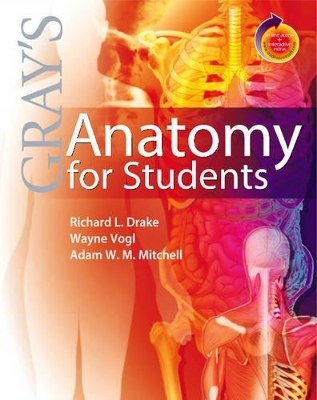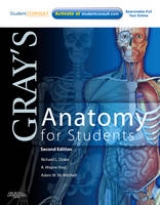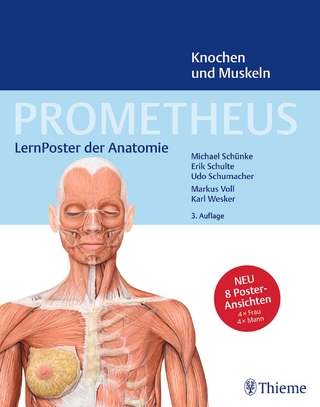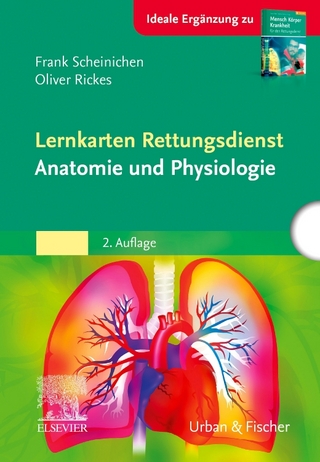
Gray's Anatomy for Students
Churchill Livingstone
978-0-443-06612-2 (ISBN)
- Titel erscheint in neuer Auflage
- Artikel merken
"Gray's Anatomy for Students" is a new and wholly original textbook of anatomy for medical and health professional students. Designed to be suitable for any type of curriculum, "Gray's Anatomy for Students" presents the essentials of clinical anatomy in a way that furthers complete understanding and firmly relates the study of anatomy to the clinical practice of medicine. Organized by region, the book provides, in each chapter, a conceptual overview that describes the function of structures within that region. The regional anatomy is described with frequent discussion of clinical relevance and illustrated with many imaging studies and an outstanding art program. Each chapter also contains a unique section on Surface Anatomy with outstanding photographs overlaid with anatomic diagrams - the focus of which is to relate anatomy to the physical examination of patients and the performance of medical procedures which require a knowledge of anatomy. Clinical Cases are used throughout to illustrate the relevance of anatomy to the practice of clinical medicine. Stop Press!
Companion website includes: Super Image Bank; Interactive Surface Anatomy tool; Testbank with hundreds of USMLE Questions; and, a complete Anatomy Course in online Learning Modules.
Richard Drake, PhD, FAAA is a Director of Anatomy, Professor of Surgery in Cleveland Clinic Lerner College of Medicine, Case Western Reserve University, Cleveland, Ohio, USA.
Chapter 1. Introduction Why this book? How to use this book The Basics: The Anatomical Plane . Body Planes (Sagittal, Coronal, Transverse (horizontal)) . Terms of Position (medial, lateral, superior, inferior, anterior, posterior) . Concept of superficial and deep - relative and absolute . Terms defining movement (flex, extend, abduct, adduct, etc) . Basic Body Plan (tubular and segmented) . Compartmentatation . Body Regions Chapter 2. Back Conceptual Overview: General description . Functions . Component parts . Relationship to other regions . Key features Regional Anatomy: Bones . Major ligaments . Muscles . Important vessels . Organization of nervous system Surface Anatomy: C7 spine . C6 spine . Scapula . Erector spinae mass . Trapezius . Latissimus dorsi . Rhomboid muscle mass Clinical Correlations: Lumbar taps . Disc herniation . Anesthesia . Whiplash Chapter 3. Thorax Conceptual Overview: General description . Functions . Component parts . Relationship to other regions . Key features Regional Anatomy:Thoracic walls and boundaries . Thoracic viscera and other contents . Heart, great vessels, vasculature . Esophagus . Thymus . Nerves of the thorax . Mediastinum Surface Anatomy: Vertebral Level T4/5 . Left brachiocephalic . Hemiazygos system . Heart projection . Projection of valves/positioning of stethoscope for valve sounds . Pleural projections (lobes) . Costodiaphragmatic recesses/ inserting chest tubes Clinical Correlations Thoracic Wall: Rib abnormalities . Traumatic injuries: fractures ribs, flail chest, rib dislocation, rib separation . Sternal problems: bone marrow, incisions . Breast problems: cancer, mastectomy, lumpectomy Thoracic inlet syndrome Needle through intercostal space Herpes zoster Lungs: Pneumothorax . Pleuritis, pleural adhesions, hemothorax . Lung auscultation . Bronchopulmonary segments in disease . Pulmonary thromboembolism Cancer Heart: Atherosclerosis, coronary artery disease, angina, myocardial infarction, bypass surgery, pacemakers . Cardiomyopathies . Arrhythmias, conduction system diseases . Valve diseases, stenoses, prolapses, murmurs . Pericardial effusion, cardiac tamponade, pericardiocentesis . Infections, pericarditis . Congenital defects . Thrombi/emboli Mediastinum: Thymus tumors, appearance in infants (sail sign) . Coarctation of the aorta . Esophageal diseases, varices, gastroesophageal reflux, cancer . Aortic aneurysm . Lung cancer, metastases to nodes Chapter 4. Abdomen Conceptual Overview: General description . Functions . Component parts . Relationship to other regions . Key features Regional Anatomy: Walls, roof, and floor . Viscera . Vasculature . Innervation . Special structural relationships Surface Anatomy: Anterior abdominal quadrants . Umbilicus . Inguinal region . Posterior (lumbar landmarks) Clinical Correlations: Hernias . Ulcers . Neoplasia . Appendicitis . Bowel diseases . Liver diseases . Gallbladder and biliary tract diseases . Pancreatic diseases . Renal diseases and transplantation . Vascular diseases . Infectious and parasitic diseases . Congenital abnormalities and malrotations Chapter 5. Pelvis/Perineum Conceptual Overview: General description . Functions . Component parts . Relationship to other regions . Key features Regional Anatomy: Architectural framework of the pelvis and perineum . Bones . Major ligaments . Significant features of the pelvic structure . Muscles that complete the pelvic walls . Pelvic floor . Structural framework and definition of perineum . Pelvic viscera . Contents of the perineum . Nerves and arteries of the pelvis and perineum Surface Anatomy: Male perineum . Male urogenital triangle . Penis . Female perineum . Female urogenital triangle . Female and male perineum indicating dermatomes Clinical Correlations: Ectopic pregnancy . Examination of cervix . Prostatectomy and impotence . Pudendal nerve block Chapter 6. Lower Limb Conceptual Overview: General description . Functions . Component parts . Relationship to other regions . Key features Regional Anatomy: Transition between pelvic girdle and thigh . The thigh . Transition between thigh and leg . The leg . Transition between leg and foot Surface Anatomy: Gait . Genu valgum and genu varum . Palpation of the femoral artery . Gluteal injections . Dorsalis pedis pulse Clinical Correlations: Hip fractures and dislocations . Femur fractures . Varicose veins . Saphenous vein grafts . Hip and thigh contusions . Superior gluteal nerve injury . Compartment syndromes in the leg . Common peroneal (fibular) nerve injuries . Common knee joint injuries . Ankle joint injuries Chapter 7. Upper Limb Conceptual Overview: General description . Functions . Component parts . Relationship to other regions . Key features Regional Anatomy: Transition between trunk and arm . Transition between the arm and forearm . The forearm . Transition between forearm and hand . The hand Surface Anatomy: Pectoral region and axilla . Medial site of arm and elbow, brachial artery . Anterior elbow, cubital fossa . Anterior aspect of forearm and palm, flexor retinaculum, major tendons, nerves, and arteries . Hand, thenar and hypothenar eminences, superficial and deep palmar arches, normal cascade of fingers . Dorsal hand and anatomical snuff box, major tendons and radial artery Clinical Correlations: Humerus fracture at spiral groove . Humerus mid-shaft fracture . Cervical disc herniation Chapter 8. Head and Neck Conceptual Overview: General description . Functions . Component parts . Relationship to other regions . Key features Regional Anatomy Head: Cranial cavity . Face and scalp . Orbit . Temporal and infratemporal regions . Ear Neck: Bones and superficial structures . Triangles of the neck . Root of the neck Midline structures: Nose and paranasal sinuses . Mouth and associated structures . Larynx . Pharynx Lymphatics of the head and neck: Surface Anatomy: Bony landmarks . Inside of mouth . Triangles of the neck . Oral cavity . Eye and eyelid . Ear . Laryngoscopic view of back of tongue, epiglottis, larynx Clinical Correlations: Skull fractures . Facial nerve injuries . Scalp injuries . Oculomotor nerve palsy . Horner syndrome . TMJ problems . Thyroid gland problems . Laryngeal injuries
| Erscheint lt. Verlag | 5.10.2004 |
|---|---|
| Zusatzinfo | 1000 full colour illustrations |
| Verlagsort | London |
| Sprache | englisch |
| Maße | 216 x 276 mm |
| Gewicht | 2425 g |
| Themenwelt | Medizin / Pharmazie ► Medizinische Fachgebiete |
| Studium ► 1. Studienabschnitt (Vorklinik) ► Anatomie / Neuroanatomie | |
| ISBN-10 | 0-443-06612-4 / 0443066124 |
| ISBN-13 | 978-0-443-06612-2 / 9780443066122 |
| Zustand | Neuware |
| Haben Sie eine Frage zum Produkt? |
aus dem Bereich



